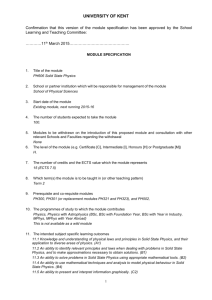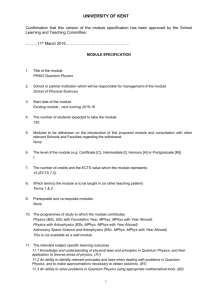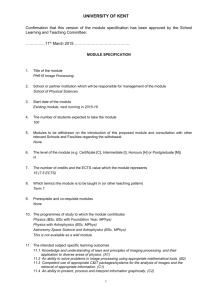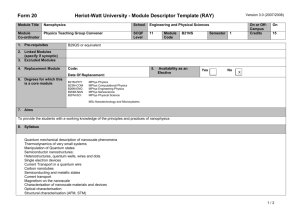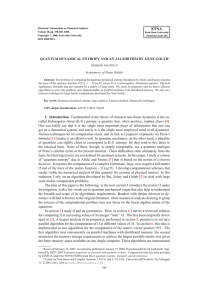University of Kent
advertisement
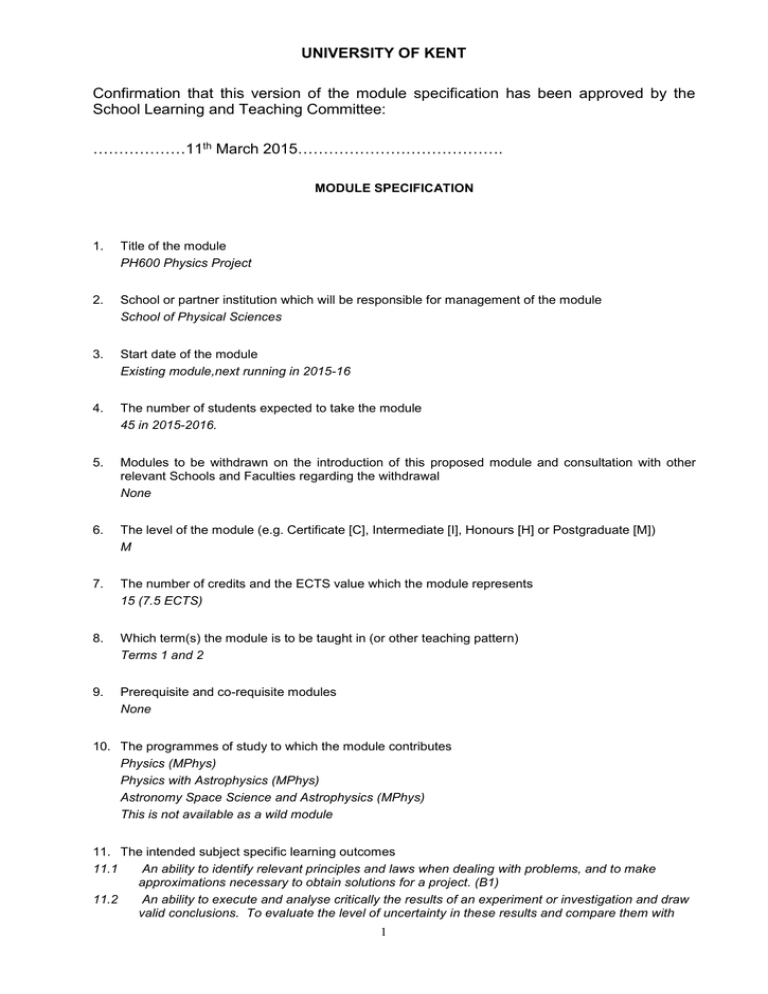
UNIVERSITY OF KENT Confirmation that this version of the module specification has been approved by the School Learning and Teaching Committee: ………………11th March 2015…………………………………. MODULE SPECIFICATION 1. Title of the module PH600 Physics Project 2. School or partner institution which will be responsible for management of the module School of Physical Sciences 3. Start date of the module Existing module,next running in 2015-16 4. The number of students expected to take the module 45 in 2015-2016. 5. Modules to be withdrawn on the introduction of this proposed module and consultation with other relevant Schools and Faculties regarding the withdrawal None 6. The level of the module (e.g. Certificate [C], Intermediate [I], Honours [H] or Postgraduate [M]) M 7. The number of credits and the ECTS value which the module represents 15 (7.5 ECTS) 8. Which term(s) the module is to be taught in (or other teaching pattern) Terms 1 and 2 9. Prerequisite and co-requisite modules None 10. The programmes of study to which the module contributes Physics (MPhys) Physics with Astrophysics (MPhys) Astronomy Space Science and Astrophysics (MPhys) This is not available as a wild module 11. The intended subject specific learning outcomes 11.1 An ability to identify relevant principles and laws when dealing with problems, and to make approximations necessary to obtain solutions for a project. (B1) 11.2 An ability to execute and analyse critically the results of an experiment or investigation and draw valid conclusions. To evaluate the level of uncertainty in these results and compare them with 1 UNIVERSITY OF KENT 11.3 11.4 11.5 11.6 11.7 11.8 11.9 11.10 11.11 11.12 11.13 11.14 11.15 expected outcomes, theoretical predictions or with published data; thereby to evaluate the significance of their results in this context. (B3) An ability to use mathematical techniques and analysis to model physical behaviour. (B4) An ability to plan an experiment or investigation under supervision and to understand the significance of error analysis. (B8) A working knowledge of a variety of experimental, mathematical and/or computational techniques applicable to current research within physics. (B9) Competent use of appropriate C&IT packages/systems for the analysis of data and the retrieval of appropriate information. (C1) An ability to present and interpret information graphically within a physics project. (C2) An ability to communicate scientific information, in particular to produce clear and accurate scientific reports. (C3) A familiarity with laboratory apparatus and techniques, including relevant aspects of Health & Safety. (C4) The systematic and reliable recording of experimental data. (C5) An ability to make use of appropriate texts, research-based materials or other learning resources as part of managing their own learning. (C6) C&IT skills which show fluency at the level and range needed for project work such as familiarity with a programming language, simulation software or the use of mathematical packages for manipulation and numerical solution of equations. (C7) An ability to communicate complex scientific ideas, the conclusion of an experiment, investigation or project concisely, accurately and informatively. (C8) Experimental skills showing the competent use of specialised equipment, the ability to identify appropriate pieces of equipment and to master new techniques and equipment. (C9) An ability to make use of research articles and other primary sources within a project. (C10) 12. The intended generic learning outcomes 12.1 Problem-solving skills, in the context of both problems with well-defined solutions and openended problems; an ability to formulate problems in precise terms and to identify key issues, and the confidence to try different approaches in order to make progress on challenging problems. Numeracy is subsumed within this area. (D1) 12.2 Investigative skills in the context of independent investigation including the use of textbooks and other available literature, databases, and the interaction with colleagues to extract important information. (D2) 12.3 Communication skills in the area of dealing with surprising ideas and difficult concepts, including listening carefully, reading demanding texts and presenting complex information in a clear and concise manner. C&IT skills are an important element to this. (D3) 12.4 Analytical skills – associated with the need to pay attention to detail and to develop an ability to manipulate precise and intricate ideas, to construct logical arguments and to use technical language correctly. (D4) 12.5 Personal skills – the ability to work independently, to use initiative, to organise oneself to meet deadlines and to interact constructively with other people. (D5) 13. A synopsis of the curriculum Aims: 1. To provide either i) experimental or theoretical projects to give an introduction to scientific research procedures, or ii) experience of the process of critical scientific review, or iii) experience of the development of teaching or Public Understanding of Science material. 2. To deepen knowledge in a specialised field and be able to communicate that knowledge orally and in writing. A choice of projects will be made available at the start of the Autumn term, to include such activities as experimental measurement and observation, the analysis of scientific information, the design and 2 UNIVERSITY OF KENT construction of electronic devices, the implementation and development of computational methods, the review of topics of current scientific interest, and the development and evaluation of new teaching aids. 14. Indicative Reading List Astrophysical jets and beams - Smith, Michael D. 2012 (electronic resource) The Landau Theory of Phase Transitions: Application to Structural, Incommensurate, Magnetic and Liquid Crystal Systems – Toledano, Jean-Claude, Toledano, Pierre 1987 Quantum theory of many particle systems – Fetter, Alexander L, Walecka, John Dirk 2003 Introduction to the theory of thermal neutron scattering – Squires, G.L. c2012 Solid state physics – Hook, John R, Hall, H.E. 1991 Introduction to glass science and technology – Shelby, J.E. 2005 The origin of stars - Smith, Michael D. 2004 Statistical mechanics of phase transitions - Yeomans, J. M.1992 Magnetism in condensed matter - Blundell, Stephen 2001 Superconductivity, superfluids, and condensates - Annett, James F. 2004 Superconductivity of metals and alloys - Gennes, Pierre-Gilles de c1999 Superconductivity - Ketterson, J. B., Song, S. N. 1999 Quantum many-particle systems - Negele, John W., Orland, Henri c1998 Quantum Field Theory in Condensed Matter Physics - Tsvelik, Alexei M. 2007 Quantum Field Theory in Strongly Correlated Electronic Systems - Nagaosa, Naoto, Heusler, S. 2010 Quantum theory of magnetism: magnetic properties of materials – White, Robert M. 2010 Quantum theory of solids – Kittel, Charles 1985 An introduction to astrophysical fluid dynamics – Thompson, M.J. c2006 Muon spin rotation, relaxation and resonance: applications to condensed matter – Le Yaouanc, A., Réotier, Pierre Dalmas de 2011 Understanding solids: the science of materials – Tilley, R.J.D. 2013 (electronic resource) Understanding molecular simulation; from algorithms to applications – Frenkel, Dann, Smit, Berend c2002 Muon science: muons in physics, chemistry and materials: proceedings of the Fifty First Scottish Universities Summer School in Physics, St Andrews, August 1998 – Lee, S.L., Kilcoyne, S.H., Cywinski, R., Scottish Universities Summer School in Physics 1999. 15. Learning and Teaching Methods, including the nature and number of contact hours and the total study hours which will be expected of students, and how these relate to achievement of the intended module learning outcomes Contact time: 15 laboratory days This module is expected to occupy 150 total study hours, including the contact hours above. 150 hours in total, including: 1h module introduction, presentation guidance via Moodle and feedback on presentations – 11.4, 11.5, 11.7, 11.8, academic-guided research (a minimum of 70 timetabled hours) 3 UNIVERSITY OF KENT 11.1-11.15, 12.1-12.5 Independent learning (which includes research data collection and analysis, literaturebased research, private study, etc.) in preparation for submission of the Report, and for a viva voce examination (the remaining 79 hours) 11.1-11.15, 12.1-12.5 16. Assessment methods and how these relate to testing achievement of the intended module learning outcomes Coursework 100% including progress mark, project report, viva voce and self-running presentation The above assessments test students’ knowledge and understanding of laws and principles (11.1, 11.4, 11.5, 11.12, 12.4), application of techniques to model behaviour and solve problems (11.3, 11.4, 11.6, 11.7, 11.9, 11.14, 12.1) and the ability to record, analyse and communicate scientific data and information effectively (11.2, 11.6, 11.8, 11.10, 11.13, 12.3, 12.4). Students will need to manage their own studies using reference materials (11.11, 11.13, 11.15, 12.2-12.5) 17. Implications for learning resources, including staff, library, IT and space None 18. The School recognises and has embedded the expectations of current disability equality legislation, and supports students with a declared disability or special educational need in its teaching. Within this module we will make reasonable adjustments wherever necessary, including additional or substitute materials, teaching modes or assessment methods for students who have declared and discussed their learning support needs. Arrangements for students with declared disabilities will be made on an individual basis, in consultation with the University’s disability/dyslexia support service, and specialist support will be provided where needed. 19. Campus where module will be delivered: Canterbury 4




